M101 howitzer
The 105 mm M101A1 howitzer (previously designated M2A1) is an artillery piece developed and used by the United States. It was the standard U.S. light field howitzer in World War II and saw action in both the European and Pacific theaters. Entering production in 1941, it quickly gained a reputation for accuracy and a powerful punch. The M101A1 fires 105 mm high explosive (HE) semi-fixed ammunition and has a range of 12,330 yards (11,270 m), making it suitable for supporting infantry.
| M101A1 105 mm Howitzer | |
|---|---|
 U.S. Marines fire a M101A1 105 mm howitzer during a ceremony in 2005 | |
| Type | Howitzer |
| Place of origin | United States |
| Service history | |
| Wars | World War II Chinese Civil War Korean War First Indochina War Vietnam War Cambodian Civil War Laotian Civil War Insurgency in the Philippines Iran–Iraq War Lebanese Civil War Salvadoran Civil War |
| Production history | |
| Manufacturer | Rock Island Arsenal |
| Produced | 1941–1953 |
| No. built | 10,200 |
| Specifications | |
| Mass | 4,980 lb (2,260 kg) |
| Length | 19 ft 6 in (5.94 m) |
| Barrel length | 7 ft 7 in (2.31 m) L/22 |
| Width | 7 ft 3 in (2.21 m) |
| Height | 5 ft 8 in (1.73 m) |
| Shell | 105x372R |
| Caliber | 105 mm (4.1 in) |
| Breech | Horizontal-block |
| Recoil | Hydro-pneumatic, constant, 42 in (110 cm) |
| Carriage | split trail |
| Elevation | -5° to +66° |
| Traverse | 46° |
| Muzzle velocity | 1,550 ft/s (472 m/s) |
| Maximum firing range | 7.00 mi (11,270 m) |
All of these qualities of the weapon, along with its widespread production, led to its adoption by many countries after the war. Its ammunition type also became the standard for many foreign countries' later models.
History
Development and designation
After World War I, the U.S. Army Ordnance Department studied various captured German 105 mm-caliber howitzers and developed the 105 mm Howitzer M1920 on Carriage M1920. A box trail carriage design (the M1925E carriage) and two other split trail designs (the T1 and T2) were also developed, but the original split trail design was found superior after testing. After being selected, the piece was standardized in December 1927 as the 105 mm howitzer M1 on carriage M1. The Army had an intention to replace all 75 mm gun-howitzers in its divisional and non-divisional field artillery regiments with 105 mm pieces, but a lack of appropriations stalled the idea and eventually forced it to be completely abandoned by 1929; a limited plan developed in 1925 envisioned re-equipping three regiments, but by 1933, only 14 M1 howitzers had been manufactured,
A modified version of the M1 was trialed in 1932 which used semi-fixed ammunition instead of separate-loading ammunition. Since this development required a different breech block, the new piece was designated the 105 mm howitzer M2 on carriage M1. 48 pieces were manufactured in 1939. The original M1 carriage had been designed for towing using horses rather than trucks, and a new carriage, the T5 (M2), was developed in 1939 and standardized in February 1940. The breech ring of the howitzer M2 was modified in March 1940 before large-scale production began, creating the 105 mm howitzer M2A1 on carriage M2.[1]
The weapon was heavy for its calibre but this was because the gun was designed to be durable. Thus the barrel and carriage could see great use and remain functional without wearing out.[2]
The U.S. military artillery designation system was changed in 1962, redesignating the M2A1 howitzer the M101A1. The gun continued to see service in the Korean and Vietnam Wars. Though a similar model, the M102 howitzer, shared the same roles in battle, it never fully replaced the M101A1. Today, the M101A1 has been retired by the U.S. military, though it continues to see service with many other countries. By the end of the Second World War, 8,536 105 mm towed howitzers had been built and post-war production continued at Rock Island Arsenal until 1953, by which time 10,202 had been built.
Use by non-US militaries
The Canadian Forces used the M2A1 as the C2 howitzer until 1997, when a modification was made to extend its service life; it is now designated the C3. The changes include a longer barrel, a muzzle brake, reinforced trails and the removal of shield flaps. It remains the standard light howitzer of Canadian Forces Reserve units. The C3 is used by Reserve units in Glacier National Park in British Columbia as a means of avalanche control.
France and the State of Vietnam used M2A1 howitzers during the First Indochina War, as did the Viet Minh guerilla forces they fought against, who were supplied with at least 24 by the People's Republic of China, along with other captured American artillery pieces and mortars formerly operated by both Nationalist Chinese forces (the Kuomintang military) and US troops fighting in Korea. Today upgraded M2A1 howitzers (some of which have been mounted on trucks and employed as self-propelled artillery) are still being used by the People's Army of Vietnam (the PAVN).[3]
The French Army used the M2 howitzer, designated HM2, in the Algerian War[4] and during the Opération Tacaud in Chad.[5] France later supplied a battery of HM2 to the Rwandan Armed Forces during the Rwandan Civil War that led into the Rwandan genocide.[6]
Present use
In addition, the M101 has found a second use in the U.S. as an avalanche control gun, supervised by the US Forest Service and the US Army TACOM's cooperative effort in the Avalanche Artillery Users of North America Committee (AAUNAC). The M101 is used by a number of ski areas and state departments of transportation for long-range control work. Under the designation of M2A2, the 2nd Battalion, 2nd Field Artillery Regiment, 428th Field Artillery Brigade performs salutes with 7 guns with World War Two Medal of Honor recipient names on their barrels.[7]
A number of M2/M101 howitzers were used by the Socialist Federal Republic of Yugoslavia and approximately 50 were inherited by Croatia, of which four are still in use for training with the Croatian Army.
M2 Howitzers are still in limited service in the Australian Army Reserve, but are being replaced with 81-millimetre (3.2 in) mortars with an emphasis on the retention of indirect fire support skills.[8] In regular service they were replaced by the 105 mm L119 Hamel gun and the 155-millimetre (6.1 in) M198 howitzers.
Two M2 howitzers (1942) are still employed in providing the gun salute at Kristiansten Fortress, in Trondheim, Norway. M101/M2 is one of three approved salute guns in the Norwegian armed forces, and have been reduced to a caliber of 75 millimetres (3.0 in) for this purpose. They are used for gun salute also at Rena and Setermoen.
Five M101A1 howitzers are owned by the Virginia Military Institute and are used for parades, evening retreat and other ceremonies.
Variants
Gun variants:
- M1920 – prototype.[9]
- M1925E – prototype.[9]
- T2 prototype, standardized as M1.[9]
- M2 (1934) – minor changes to the chamber to allow use of fixed ammunition.[9]
- M2A1 (1940) – modified breech ring.[10]
- M3 – lightweight howitzer, with barrel shortened by 27 inches.
- T8 prototype (standardized as 105 mm M4 Howitzer in September, 1943) – vehicle-mounted variant with modified breech and with cylindrical recoil surface.[11]:210
- M101 – post-war designation of M2A1 on carriage M2A1
- M101A1 – post-war designation of M2A1 on carriage M2A2
- M2A1 modernized variant by Yugoimport SDPR with max range of 18.1kmm and 8rds per minute[12]
- C3 – Canadian C1 (M2A1) with lengthened, 33-caliber barrel
Carriage variants:
- M1920E – prototype, split trail.[9]
- M1921E – prototype, box trail.[9]
- M1925E – prototype, box trail.[9]
- T2, standardized as M1 – split trail, wooden wheels.[9]
- M1A1 – M1 carriages rebuilt with new wheels, brakes and other parts.[10]
- T3 – prototype.[9]
- T4 – prototype.[9]
- T5, standardized as M2 (1940) – split trail, steel wheels with pneumatic tires.[9]
- M2A1 – electric brakes removed.[13]
- M2A2 – modified shield.[13]
- XM124 & XM124E1 Light Auxiliary Propelled Howitzer – prototype (1962–1965) – produced by Sundstrand Aviation Corporation, who added an auxiliary drive system for local maneuverability (See also similar XM123 Medium Auxiliary Propelled 155 mm Howitzer with similar configuration). The base XM124 provided two 20 horsepower, air-cooled engines, while the XM124E1 provided a single 20 horsepower engine and electric steering.
- M2A2 Terra Star Auxiliary Propelled Howitzer – prototype (1969–1977) – Lockheed Aircraft Service Company added an auxiliary drive system and a tri-star wheel system to the carriage of an M2A2 105 mm Light Howitzer to provide local maneuverability. The last surviving example is at the Rock Island Arsenal Museum.
 Canadian soldiers fire a high explosive round with a C3 howitzer in 2009.
Canadian soldiers fire a high explosive round with a C3 howitzer in 2009. Royal Thai army M101 with new barrel.
Royal Thai army M101 with new barrel. XM124E2 Light Auxiliary-Propelled 105 mm Howitzer at the Rock Island Arsenal museum
XM124E2 Light Auxiliary-Propelled 105 mm Howitzer at the Rock Island Arsenal museum The only surviving prototype M2A2 Terra Star Auxiliary Propelled Howitzer at the Rock Island Arsenal Museum. Note the tri-star wheel system and auxiliary drive system on the right trail leg.
The only surviving prototype M2A2 Terra Star Auxiliary Propelled Howitzer at the Rock Island Arsenal Museum. Note the tri-star wheel system and auxiliary drive system on the right trail leg.
Self-propelled mounts
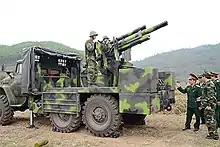
- Medium Tank M4A4E1 – M2A1 in mount T70.[11]:568
- Medium Tank M4(105), M4A3(105) – M4 in mount M52.[11]:568
- Medium/Heavy Tank M45 – M4 in mount M71.[14]:233
- Experimental mount on Holt tractor – M1920.[15]:317
- Experimental chassis designed by J Walter Christie – M1920.[15]:317
- 105 mm Howitzer Motor Carriage T9 (based on Cletrac MG-2 tractor).[15]:329
- 105 mm Howitzer Motor Carriage T19 (based on M3 halftrack) – M2A1.[16]:236
- 105 mm Howitzer Motor Carriage T32 / M7 – M2A1.[11]:568
- 105 mm Howitzer Motor Carriage T76 / M37 (Light Tank M24 chassis) – M4 in mount M5.[15]:329
- 105 mm Howitzer Motor Carriage T88 (76 mm GMC M18 chassis) – M4 in mount M20.[15]:334
- K105HT 105 mm howitzer mounted on an armored 5-ton truck system built by Samsung Techwin for the Republic of Korea Army
- Vietnamese M101 howitzer mounted on an Ural-375D 6×6 truck.[17]
Ammunition
The gun fired semi-fixed ammunition, with 105 mm Cartridge Case M14. The propelling charge consisted of a base charge and six increments, forming seven charges from 1 (the smallest) to 7 (the largest). Use of M1 HE rounds prepared for the 105 mm howitzer M3 (same projectile and cartridge, but different propelling charge) was authorized.[18]
HEAT M67 Shell was originally designed as fixed round, with Cartridge Case M14 type II. It was later changed to semi-fixed type with the standard cartridge, but with non-adjustable propelling charge. For blank ammunition, a shorter Cartridge Case M15 with black powder charge was used.[18]
| Available ammunition[16]:236[18][19] | |||||
| Type | Model | Weight, kg (round/projectile) | Filler | Muzzle velocity, m/s | Range, m |
| HE | HE M1 Shell | 19.08 / 14.97 | TNT or 50/50 amatol, 2.18 kg | 472 | 11,160 |
| HE-AT | HE-AT M67 Shell | 16.71 / 13.25 | Pentolite, 1.33 kg | 381 | 7,854 |
| Smoke | HC BE M84 Shell | 19.02 / 14.91 | Zinc chloride (HC) | 472 | 11,160 |
| Smoke, colored | BE M84 Shell | 17.86–18.04 / | Smoke mixture | ||
| Smoke | WP M60 Shell | 19.85 / 15.56 | White Phosphorus (WP), 1.84 kg | 472 | 11,110 |
| Smoke | FS M60 Shell | 20.09 / | Sulfur trioxide in Chlorosulfonic acid, 2.09 kg | ||
| Chemical | H M60 Shell | 19.43 / | Mustard gas, 1.44 kg | ||
| Practice | Empty M1 Shell | 472 | 11,160 | ||
| Drill | Drill Cartridge M14 | - | - | ||
| Blank | - | - | |||
| Armor penetration, mm[16]:236[20][21] | ||||
| Ammunition \ Distance, m | 0 | 457 | 914 | 1,828 |
| HEAT M67 Shell (meet angle 0°) | 102-183 | |||
| Concrete penetration, mm[16]:236 | ||||
| HE M1 Shell (meet angle 0°) | 457 | 427 | 396 | 335 |
| Different methods of measurement were used in different countries / periods. Therefore, direct comparison is often impossible. | ||||
Operators
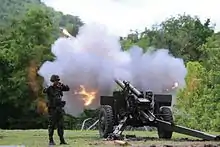
 Argentina[22]
Argentina[22].svg.png.webp) Australia
Australia Austria: Haubitze M1A2
Austria: Haubitze M1A2 Bahrain
Bahrain Bangladesh M101A1 variant. 50 delivered in 1982. Status uncertain.[23]
Bangladesh M101A1 variant. 50 delivered in 1982. Status uncertain.[23].svg.png.webp) Belgium[24]
Belgium[24] Benin[25]
Benin[25] Bolivia[26]
Bolivia[26] Bosnia and Herzegovina
Bosnia and Herzegovina Brazil[27]
Brazil[27] Burkina Faso[28]
Burkina Faso[28] Cameroon[29]
Cameroon[29].svg.png.webp) Canada Designated C3[30] - Canadian C1[24] (M2A1) with lengthened, 33-caliber barrel
Canada Designated C3[30] - Canadian C1[24] (M2A1) with lengthened, 33-caliber barrel Chad[31]
Chad[31] Chile[32]
Chile[32] Republic of China[33]
Republic of China[33] Colombia[34]
Colombia[34] Croatia
Croatia Denmark[24]
Denmark[24] Dominican Republic[35]
Dominican Republic[35] Ecuador[36]
Ecuador[36] Ethiopia
Ethiopia El Salvador
El Salvador France[24]
France[24] Gabon[37]
Gabon[37] Germany (As salute gun only)
Germany (As salute gun only) Greece[24][38]
Greece[24][38] Guatemala[39]
Guatemala[39] Honduras
Honduras
 Indonesia
Indonesia Iran[40][41]
Iran[40][41]%253B_Flag_of_Syria_(1963%E2%80%931972).svg.png.webp) Iraq[40]
Iraq[40] Japan
Japan South Korea[42]
South Korea[42] Khmer Republic
Khmer Republic Laos[43][44]
Laos[43][44] Lebanon[45]
Lebanon[45] Liberia[46]
Liberia[46] Lithuania[47]
Lithuania[47] North Macedonia[48]
North Macedonia[48] Malaysia
Malaysia Mauritania[49]
Mauritania[49] Madagascar[50]
Madagascar[50] Mexico[51]
Mexico[51] Morocco[52]
Morocco[52]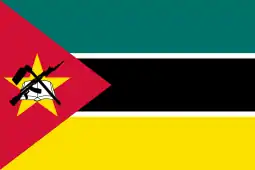 Mozambique[53]
Mozambique[53] Myanmar - 242 in service[54]
Myanmar - 242 in service[54] Netherlands[24]
Netherlands[24] New Zealand
New Zealand Nicaragua
Nicaragua Norway[24]
Norway[24] Pakistan[55]
Pakistan[55] Paraguay[56]
Paraguay[56] Peru[57]
Peru[57] Philippines[58]
Philippines[58] Portugal[24][59]
Portugal[24][59].svg.png.webp) Rhodesia[60]
Rhodesia[60].svg.png.webp) Rwanda[6]
Rwanda[6]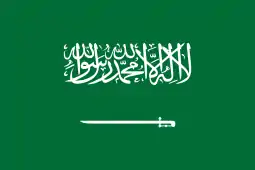 Saudi Arabia[61]
Saudi Arabia[61] Senegal[62]
Senegal[62] South Africa[63]
South Africa[63] Spain[24]
Spain[24] Sudan[64]
Sudan[64] Thailand[65]
Thailand[65]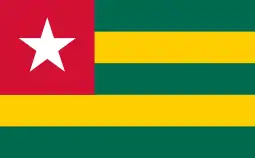 Togo
Togo Tunisia[66]
Tunisia[66] Turkey[24][67]
Turkey[24][67] United States[68]
United States[68] Uruguay[69]
Uruguay[69] Venezuela[70]
Venezuela[70] Vietnam[3]
Vietnam[3]
See also
- List of U.S. Army weapons by supply catalog designation (SNL C-21)
- List of U.S. Army weapons by supply catalog designation#Group "R" Material (Shell (projectile)#Separate loading cased charge) Ammunition for 105 mm M2, M2A1, and M4 Howitzer (AIC R1Q or R1U)
- L118 Light Gun – Lightweight 105 mm howitzer designed in the 1970s
- LG1 – Modern lightweight 105 mm howitzer
- G7 – Modern 105 mm howitzer
- M56 105 mm similar to the M101 made in ex Yugoslavia and still made in Serbia including new and old variant and Bosnia only old variant
Notes
- Zaloga, Steven (2011). U.S. Field Artillery of World War II. Bloomsbury. p. 10-11.
- Bishop, Chris. The encyclopedia of weapons of world War II. Sterling Publishing Company, Inc., 2002, p.139
- Military Balance 2016, p. 297.
- Jung, Norbert (2009). "L'artillerie dans la lutte contre-insurrectionnelle en Algérie (1954–1962)". Stratégique (in French). 1 (93-94–95-96): 409–424. doi:10.3917/strat.093.0409. Archived from the original on 2015-12-09. Retrieved 2019-03-14.
- Merchet, Jean-Dominique (22 July 2008). "Quand tire l'artillerie" [When artillery fires]. secretdefense.blogs.liberation.fr (in French). Archived from the original on 29 March 2019. Retrieved 14 March 2019.
- Isnard, Jacques (17 February 1993). "Rwanda: selon les services de renseignementfrançais, Les rebelles bénéficieraient du soutien de l'armée ougandaise" (PDF). Le Monde (in French). p. 5.
- "428th Field Artillery Brigade | Fort Sill | Oklahoma | Fires Center of Excellence". sill-www.army.mil. Archived from the original on 2018-07-05. Retrieved 2018-07-05.
- Toohill, MAJ Ian (August 2009). "Mortars for Reserve Gunners" (PDF). The Bayonet. 2nd Division, Army Reserves Public Affairs. p. 10. Archived from the original (PDF) on 27 February 2012. Retrieved 6 January 2012.
- Hogg – Allied Artillery of World War Two, p 42–49.
- Technical Manual TM 9-2005 volume 3, Infantry and Cavalry Accompanying Weapons.
- Hunnicutt – Sherman: A History of the American Medium Tank
- "Archived copy" (PDF). Archived (PDF) from the original on 2018-04-05. Retrieved 2018-04-04.CS1 maint: archived copy as title (link)
- Technical Manual TM 9-1325, 105 mm Howitzers M2 and M2A1; Carriages M2A1 and M2A2; and Combat Vehicle Mounts M3 and M4.
- Hunnicutt – Pershing: A History of the Medium Tank T20 Series
- Hunnicutt – Stuart: A History of the American Light Tank
- Hunnicutt – Half-Track: A History of American Semi-Tracked Vehicles
- "Vietnam Has Developed a 105 mm Self-Propelled Howitzer on a Ural-375D Chassis 20051531 – May 2015 Global Defense Security news UK – Defense Security global news industry army 2015 – Archive News year". www.armyrecognition.com. Archived from the original on 2015-05-24.
- Technical Manual TM 9-1901, Artillery Ammunition, p 167–178.
- Technical Manual TM 9-1904, Ammunition Inspection Guide, p 471-484.
- "Archived copy" (PDF). Archived (PDF) from the original on 2018-07-27. Retrieved 2017-06-13.CS1 maint: archived copy as title (link)
- "Archived copy" (PDF). Archived (PDF) from the original on 2017-05-17. Retrieved 2017-06-13.CS1 maint: archived copy as title (link)
- Military Balance 2016, p. 377.
- "Trade-Register-1971-2018.rft". Stockholm International Peace Research Institute. Retrieved 2019-04-21.
- Wiener, Friedrich (1987). The armies of the NATO nations: Organization, concept of war, weapons and equipment. Truppendienst Handbooks Volume 3. Vienna: Herold Publishers. p. 494-495.
- Military Balance 2016, p. 430.
- Military Balance 2016, p. 380.
- Military Balance 2016, pp. 383-384.
- Military Balance 2016, p. 432.
- Military Balance 2016, p. 434.
- Military Balance 2016, p. 35.
- "Trade Registers". Armstrade.sipri.org. Archived from the original on 13 May 2011. Retrieved 15 March 2019.
- Military Balance 2016, p. 387.
- Military Balance 2016, p. 291.
- Military Balance 2016, p. 390.
- Military Balance 2016, p. 394.
- Military Balance 2016, p. 396.
- Military Balance 2016, p. 446.
- Military Balance 2016, p. 104.
- Military Balance 2016, p. 399.
- Razoux, Pierre (2015). The Iran–Iraq War. Translated by Elliott, Nicholas. Cambridge, Massachusetts and London, England: Harvard University Press. pp. 517, 523. ISBN 978-0-674-08863-4.
- Military Balance 2016, p. 328.
- Military Balance 2016, p. 267.
- Conboy, Kenneth (23 Nov 1989). The War in Laos, 1960–75. Men-at-Arms 217. Osprey Publishing. p. 15. ISBN 978-0-85045-938-8.
- Military Balance 2016, p. 271.
- Military Balance 2016, p. 340.
- "Trade Registers". armstrade.sipri.org. Archived from the original on 2010-04-14.
- Military Balance 2016, p. 116.
- Krott, Rob (October 2003). "Macedonia's Weaponry: A New Nation Re-Arms and Fights". Small Arms Review. Vol. 7 no. 1. Archived from the original on 2019-03-30. Retrieved 2019-03-30.
- Military Balance 2016, p. 343.
- Military Balance 2016, p. 454.
- Military Balance 2016, p. 404.
- Military Balance 2016, p. 345.
- Military Balance 2016, p. 458.
- Military Balance 2016, p. 276.
- Military Balance 2016, p. 280.
- Military Balance 2016, p. 408.
- Military Balance 2016, p. 410.
- Military Balance 2016, pp. 284-285.
- Military Balance 2016, p. 130.
- John Keegan, page 589 World Armies, ISBN 0-333-17236-1
- Military Balance 2016, p. 351.
- Military Balance 2016, p. 464.
- Engelbrecht, Leon. "Fact file: G6 L45 self-propelled towed gun-howitzer – defenceWeb". www.defenceweb.co.za. Archived from the original on 2014-01-09.
- Military Balance 2016, p. 471.
- Military Balance 2016, p. 293.
- Military Balance 2016, p. 356.
- Military Balance 2016, p. 148-150.
- Military Balance 2016, p. 44.
- Military Balance 2016, p. 414.
- Military Balance 2016, p. 416.
References
- Hogg, Ian V. (1998). Allied Artillery of World War Two. Crowood Press, Ramsbury. ISBN 1-86126-165-9.
- Hunnicutt, R. P. (1971). Pershing: A History of the Medium Tank T20 Series. Feist Publications.
- Hunnicutt, R. P. (1992). Stuart: A History of the American Light Tank. Presidio Press. ISBN 0-89141-462-2.
- Hunnicutt, R. P. (1994). Sherman: A History of the American Medium Tank. Presidio Press. ISBN 0-89141-080-5.
- Hunnicutt, R. P. (2001). Half-Track: A History of American Semi-Tracked Vehicles. Presidio Press. ISBN 0-89141-742-7.
- Technical Manual TM 9-1325, 105 mm Howitzers M2 and M2A1; Carriages M2A1 and M2A2; and Combat Vehicle Mounts M3 and M4. War Department, 1944.
- Technical Manual TM 9-1901, Artillery Ammunition. War Department, 1944.
- Technical Manual TM 9-1904, Ammunition Inspection Guide. War Department, 1944.
- Technical Manual TM 9-2005 volume 3, Infantry and Cavalry Accompanying Weapons. War Department, 1942.
- International Institute for Strategic Studies (February 2016). The Military Balance 2016. 116. Routlegde. ISBN 978-1-85743-835-2.
External links
| Wikimedia Commons has media related to M101 105 mm howitzer. |
- Two Guns For One, November 1942, Popular Science one of the earliest detailed public article published on the M101 Howitzer
- FAS Military Analysis Network